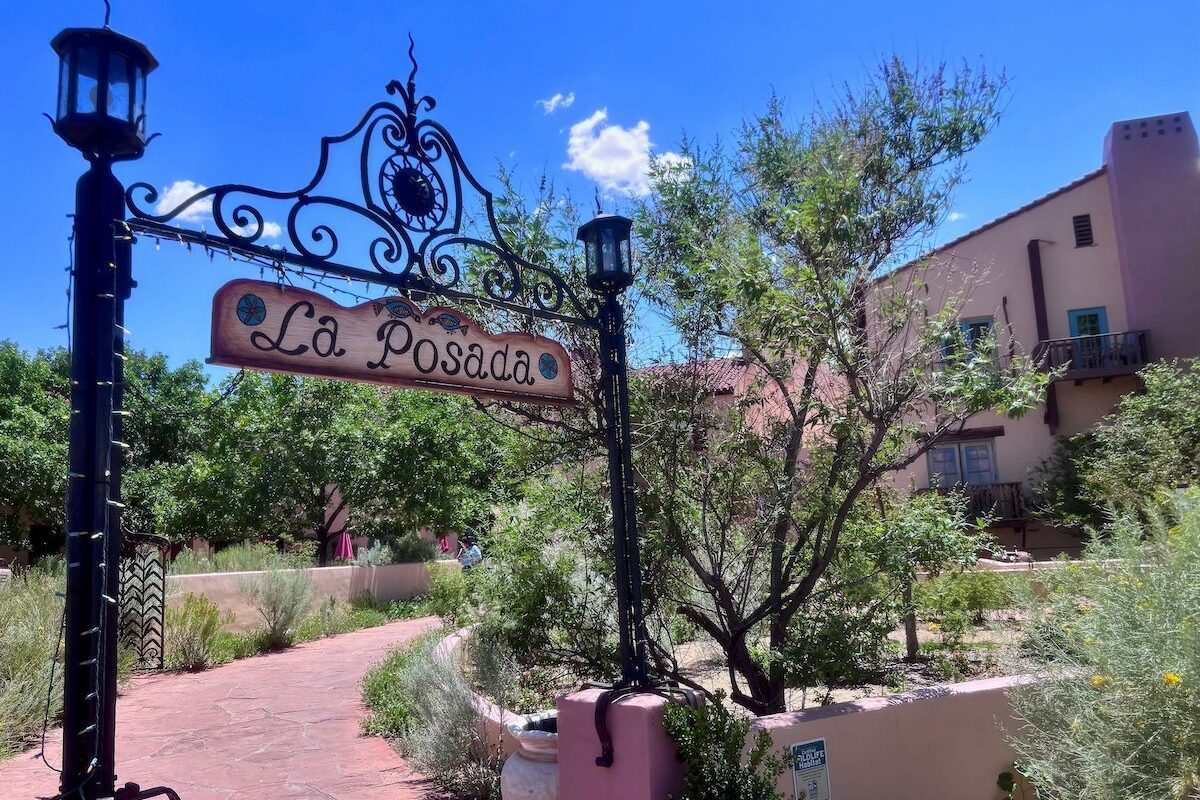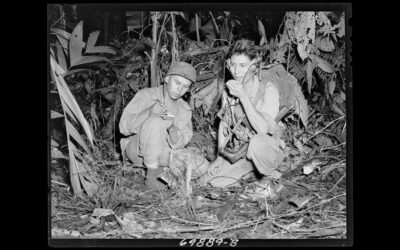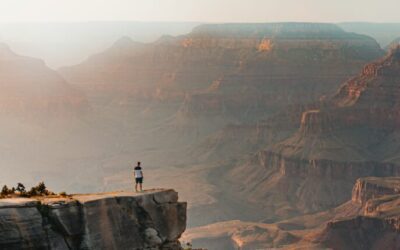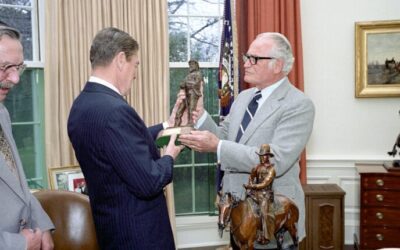
Saved from the wrecking ball, La Posada Hotel in Winslow, Arizona, recalls a more graceful era of travel. (USA TODAY Network)
Stepping into one of Arizona‘s oldest hotels might feel like time traveling to a different era, following the footsteps of famous figures from the past, or a prelude to encountering a ghost.
The stories of the state’s historic lodges are full of resilience, overcoming natural and economic disasters, and in one case, a brush with a murderous gang of bank robbers.
Not all of these stories are a century old just yet, but they’re close.
Here’s a look at nine of the state’s oldest accommodations, from destination hotels that anchor their cities’ downtown districts to resorts whose guest lists include many celebrities of yesteryear to the only lodge at the bottom of the Grand Canyon.
Tucson: Hotel Congress
Opened: 1919.
This landmark downtown Tucson hotel has a storied place in the southern Arizona city’s history. Built in the Mission Revival architecture style, it was constructed to serve railroad passengers arriving at Tucson’s downtown train depot. It’s stood for many years as a vibrant nightlife venue, and its famous bar Tiger’s Tap Room was well-known for its namesake bartender, affectionately known as Tiger, who worked at the Tap Room for more than 60 years.
But the biggest claim to Hotel Congress’s fame is its role in the capture of notorious bank robber John Dillinger.
Dillinger and members of his gang arrived at the Hotel Congress in January 1934, hiding from the law after taking part in multiple deadly bank robberies. At the time, Tucson was considered a remote city and communication was limited. But when the hotel caught fire and Dillinger’s gang was evacuated from the building, some gang members were worried about their luggage and tipped firefighters $12 to retrieve it.
Suspicious of the big tip and the unusually heavy luggage, the firefighters checked an issue of the magazine “True Detective Mysteries” and identified the men who tipped them as members of Dillinger’s gang, reporting them to Tucson police. Two days after the fire, police arrested Dillinger and his gang at various locations in the city. Dillinger was the last to be captured.
Hotel Congress celebrates the anniversary of Dillinger’s capture and the role of Tucson’s police and fire departments in his capture with a Dillinger Days event every January, which includes live music and whiskey tastings.
Details: 311 E. Congress St, Tucson. 520-622-8848, hotelcongress.com.
Grand Canyon: Phantom Ranch
Opened: 1922.
Mary Colter, an architect for the Fred Harvey Company and the Santa Fe Railroad, made her name through her extensive work designing buildings at Grand Canyon National Park. She designed eight buildings on the park grounds, each built with wood and native stone, designed to evoke a rustic feel that suits the park’s natural landscape. One of those buildings was the only lodging at the canyon bottom, which offers one of the park’s most in-demand experiences.
Phantom Ranch is only accessible on foot, by mule or by rafting the Colorado River, so building the lodge was a task. Historians said the materials used to build it, except for the stones, were hauled down to the canyon bottom by mule. Much of its allure comes from its remote location, allowing people to appreciate the canyon bottom’s natural and isolated setting.
But it’s not for everyone. Getting there requires a strenuous hike or mule ride. And getting a reservation is nearly as challenging. To book a stay at Phantom Ranch, people must enter a lottery 14 months before their planned visit. Winners can book a reservation the next month.
Details: 888-297-2757, grandcanyonlodges.com.
Flagstaff: Hotel Monte Vista
Opened: 1927.
Flagstaff’s tourism boom in the 1920s inspired a community-driven fundraising campaign for a new hotel, aiming to keep visitors in town longer. The Hotel Monte Vista, its name selected by a 12-year-old contest winner, opened its doors on New Year’s Day in 1927 and stood as Arizona‘s longest publicly held commercial property until a private investor bought the hotel in the 1960s.
Monte Vista (which translates in English to “mountain view”) housed a speakeasy during Prohibition, The Cocktail Lounge, which was disguised as a newspaper publishing house. Authorities raided it in 1931 and it was forced to shut down, but it reopened two years later after Prohibition was repealed.
The hotel was also the home base for Flagstaff’s first radio station, KFXY. Mary Costigan, one of the first women to have a radio broadcasting license, moved the station from the present-day Orpheum to the hotel and broadcast a three-hour radio show from there.
Details: 100 N. San Francisco St., Flagstaff. 928-779-6971, hotelmontevista.com.
Prescott: Hassayampa Inn
Opened: 1927.
Named for the nearby Hassayampa River that flows south of Prescott, Hassayampa is an Apache word that roughly translates to “the river that flows upside down.” Prescott was a thriving tourism destination in the 1920s, and even though it had its share of hotels in the early 20th century, visitors and residents alike had an appetite for more “modern” accommodations. Hassayampa Inn opened to answer that call.
A company was formed to raise finances for the hotel, but efforts were doomed by mismanagement. So local residents raised the funds instead, with the Prescott Kiwanis Club petitioning citizens to buy $1 shares of the hotel, ultimately raising a total of $150,000. El Paso architect Henry Trost designed the three-story brick hotel in a blend of Spanish Colonial Revival and Italian Renaissance Revival architecture, and the result became a downtown landmark.
Hassayampa Inn’s notoriety over the years is owed in part to Prescott Frontier Days, the world’s oldest rodeo, for attracting rodeo visitors staying overnight, including several famous actors who visited the rodeo, such as Tom Mix, Will Rogers and Steve McQueen.
Details: 122 E. Gurley St., Prescott. 928-778-9434, hassayampainn.com.
Phoenix: Hotel San Carlos
Opened: 1928.
The Hotel San Carlos is a historical landmark in downtown Phoenix. Built on the former site of Phoenix’s first schoolhouse, it quickly became a symbol of elegance and modernity in the burgeoning city.
The San Carlos was notable for its early adoption of air conditioning, making it a standout luxury destination during a time when such amenities were rare.
The hotel’s original architecture and decor have been carefully preserved, offering guests a nostalgic experience. Initially targeting affluent travelers, Hollywood stars and business elites, the hotel now attracts a diverse clientele, including history enthusiasts, tourists and business travelers.
Known for its rooftop pool, vintage-style rooms and ghost stories, Hotel San Carlos provides a unique blend of historic allure and modern comfort.
Details: 202 N. Central Ave., Phoenix. sancarlosphoenix.top.
Phoenix: Arizona Biltmore
Opened: 1929.
This historic luxury resort was designed by Albert Chase McArthur with significant influence from Frank Lloyd Wright.
The hotel’s architecture features the distinctive geometric patterns and organic designs associated with Wright’s work. When it opened, the Arizona Biltmore had over 250,000 blocks, 33,000 pounds of copper in the roof and the second-largest gold leaf ceiling in the world. It was a symbol of opulence and sophistication in the Southwest.
The Arizona Biltmore has hosted U.S. presidents, including John F. Kennedy and Herbert Hoover, and celebrities and influential figures such as Frank Sinatra. Not to mention it’s said to be the birthplace of the tequila sunrise, invented by bartender Gene Sulit in the 1930s.
Characterized by its Art Deco design, lush gardens and lavish interiors, the Arizona Biltmore remains a premier destination in Phoenix, offering a blend of historic charm and modern luxury.
Details: 2400 E. Missouri Ave., Phoenix. arizonabiltmore.com.
Winslow: La Posada Hotel
Opened: 1930.
Like Phantom Ranch, the La Posada Hotel was the work of Mary Colter, though it differed from her work at Grand Canyon. She designed the hotel in Winslow in a Mission Revival style, taking inspiration from 19th-century Spanish ranchos. Colter considered La Posada her best work.
However, the original hotel suffered from its opening at the onset of the Great Depression. At the time, the traveling public sought more modest accommodations, and fewer people were taking trains and staying at hotels attached to the stations.
La Posada closed and was converted into office space, but was resurrected when new owners purchased the building and its grounds in 1997, restoring the hotel and planting new gardens. Today, La Posada is a key landmark of Arizona‘s stretch of historic Route 66.
Details: 303 E. Second St., Winslow. 928-289-4366, laposada.org.
Tucson: Arizona Inn
Opened: 1930.
When Isabella Greenway, Arizona‘s first woman elected to Congress, opened the Arizona Inn in 1930, she saw it as “a candle against the gathering darkness of the Great Depression,” according to Will Conroy, who compiled a history of the inn. In its first years, the inn’s guests would arrive by train and stay for months at a time, which explains why the rooms feature large cabinets. Greenway sought to bring people in for “privacy, quiet and sunshine.”
The casita-style inn hasn’t changed much since its debut nearly a century ago, with some of the most notable additions including a swimming pool in 1937 and a renovation of the main building in 1972 that included adding air conditioning. Guests who’ve stayed at the inn include Frank Sinatra, Bob Hope, John Wayne and Katherine Hepburn. Singer and Tucson native Linda Ronstadt named the Arizona Inn one of her favorite places in Tucson.
Details: 2200 E. Elm St., Tucson. 520-325-1541, arizonainn.com.
Grand Canyon Bright Angel Lodge & Cabins at the South Rim
Opened: 1935.
The Santa Fe Railroad gave Mary Colter a challenge. Grand Canyon and the historic El Tovar hotel were highly popular, but the railroad and the Fred Harvey Company wanted to offer more moderately priced lodging on the South Rim as an alternative to El Tovar.
Colter, El Tovar’s interior designer in addition to designing other historic buildings at Grand Canyon National Park, was asked to design a new lodge on the site of an aging hotel. The Bright Angel Lodge followed in the tradition of her other buildings at Grand Canyon through its incorporation of wood and native stone.
But Colter’s buildings are not the oldest in the lodge and cabins complex. There are also two historic cabins that date back to the 1890s: the Buckey O’Neill Cabin, which was the former home of a Grand Canyon hotel operator who died fighting with Theodore Roosevelt’s Rough Riders; and the Red Horse Cabin, which was originally built for the Red Horse Ranch and served as the Grand Canyon’s post office from 1910 to 1935.
Details: 9 N. Village Loop Drive, Grand Canyon. 928-638-2631, grandcanyonlodges.com.
Arizona Republic reporter Tiffany Acosta contributed to this story.
Michael Salerno is an award-winning journalist who’s covered travel and tourism since 2014. His work as The Arizona Republic’s consumer travel reporter aims to help readers navigate the stresses of traveling and get the best value for their money on their vacations. He can be reached at [email protected]. Follow him on X, formerly Twitter: @salerno_phx.
Support local journalism. Subscribe to azcentral.com today.
This article originally appeared on Arizona Republic: Book a stay with a side of history at these 9 storied Arizona hotels
Reporting by Michael Salerno, Arizona Republic / Arizona Republic
MORE: I got married in a haunted hotel & made all my spooky dreams come true

2 historic Arizona sites make 2025 endangered list
Mystery Castle and May Hicks Curtis House made the National Trust for Historic Preservation's 2025 list of America's 11 Most Endangered Historic...

This Arizona family lived the consequences of the Alien Enemies Act—now they’re watching it again
PHOENIX – The year is 1943. World War II continues to rage as the Allies and the Axis powers stray further apart. George Abe (pronounced AH-bay),...

The 10 best movies set in Arizona
From action and comedy to thrillers and heartfelt dramas, these 10 movies set in Arizona capture everything there is to love about the Grand Canyon...

6 influential women who shaped Arizona history
From breaking glass ceilings to championing for the rights of marginalized communities, these women’s stories are worth sharing. The history books...




